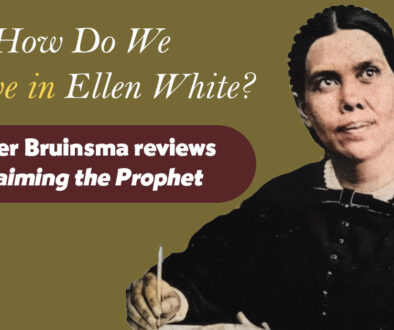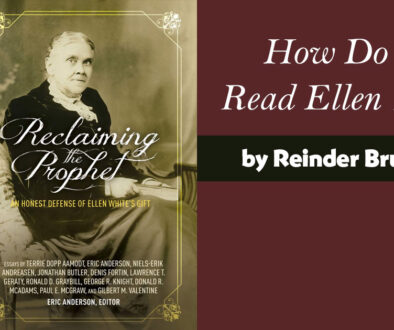The Rise of Adventism
by William Abbott, April 4, 2016: This essay looks at the comparative success Adventist missions have had over the last forty years and asks why. The Church of Jesus Christ of Latter-day Saints (LDS) has missionaries who are more numerous, better organized and certainly better focused, but the LDS have not been nearly as successful as the Seventh-day Adventists in growing their church. The Jehovah Witnesses organizationally exist solely to proselytize yet their growth rates have collapsed over the last fifteen years. It is well beyond the scope of this essay to review the histories and compare these three distinctively American, Christian sects. Personal surprise as much as anything accounts for this inquiry. Apart from the type-set evangelistic meeting, which is fading away, and ‘Ingathering’ which is history, Adventist outreach and mission has been largely opportunistic, eclectic, and relatively unfocused and uncoordinated. Yet in the final analysis it is the independence and flexibility of Adventist missions and missionaries that accounts for their remarkable success.
When I joined the Seventh-day Adventist church forty years ago there were a little over two million Adventists worldwide. Today there are over eighteen million; an eight-fold increase. By a certain way of reckoning, the Seventh-day Adventist church is now the fifth-largest Christian denomination in the world. Forty years ago there were about twice as many Mormons worldwide as there were Adventists. But today the Adventist church has twenty percent more members worldwide than the Church of Jesus Christ of Latter-day Saints. LDS membership continues to grow rapidly, but not like the Adventists’. If Adventists maintain the same growth rate for another forty years there will be over one hundred million Adventists. By 2100 there would be one billion of us. What is it about the Adventist system that leads to such growth?
I lived on Majuro Atoll in the Marshall Islands and taught school as a student missionary. The LDS (Mormon) missionaries were also active on the Island. LDS teens will usually serve as missionaries after high school. They lived nearby and we grew to be friends. I was impressed how organized and focused the LDS were. Their mission candidates were aptitude-tested for their ability to learn a foreign language before they were assigned overseas. Their mission lasted for two years, not one school term like ours. Two by two, they went out every day and tried to persuade the Marshallese to be Mormons, one soul at a time. Their proselytizing worked, and it seemed to work well.
We Adventist missionaries on the other hand ran around the Islands helter-skelter. We started schools, some succeeded, and some failed. We abandoned schools. The self-supporting Spence’s had their sailboat named Canvasback and sailed the islands doing medical work. The church took a disastrous two-year stab at administering the Marshall Islands health care system. Our student missionaries were not vetted or managed like Mormon missionaries. We had some ‘incidents’ too. We had Student Missionaries who definitely weren’t good missionaries. We Adventists believed we had the best school system in the Islands. The schools were staffed entirely with untrained, volunteer, student missionaries. It was an assumption. When they finally did do comparative testing we found the Adventist students were far behind the Catholics with their native Marshallese teachers. We were shocked.
From a tiny membership base forty years ago, there are purportedly upwards of 500,000 Chinese Adventists today. The Seventh-day Adventist church in China is not organized at all like the rest of the Seventh-day Adventist Church. It is a congregational system; very factionalized, very independent. Some factions don’t report anything to the China Union Mission – no contact. And the China Union Mission is perhaps relieved; some factions have some very ‘different’ ideas. Adventism in China is so heterodoxical, really the name and the Sabbath is all some of these Chinese Adventists share in common. In contrast, the Mormons don’t proselytize in China. One suspects the LDS structure and missionary outreach cannot bend that far nor accommodate the Communist Party’s restrictions on foreign involvement in local Chinese churches.
Adventists have a long history of pursuing mission work with independent, entrepreneurial zeal. If Mormons are the “settlers,” Adventists are the “frontiersmen.” Whether it’s a “dark” county or Pitcairn Island, Adventist missionaries have always sought to go “where no man has gone before.” The Hares, Halliwells, and Stahls, J. N. Andrews in Europe, Mrs. White in Australia, the mission doctors, the health food entrepreneurs, HMS Richards; it is a long list. The entrepreneurial spirit has not left the Adventist church; if anything, it’s stronger than ever: Maranatha, ShareHim, 3ABN, self-supporting schools, Amazing Facts, OCI, AWR, ASAP,ASI, AFM, AWA, David Gates Ministries, and countless other efforts, many nurtured under one of these umbrellas. For generations these missionaries and their missions have been the heroes and the unity of Adventism. One of the most persistent arguments in favor of women’s ordination has been the success women have had as evangelists in the “mission field.”
The Black Regional Conferences in North America are an embarrassment to some. Equality being the watchword these days, many Adventists are embarrassed at the separated races within the church. The Regional Conferences have perpetuated and even encouraged this racial dis–integration in the North American Division (NAD). But the Regional Conferences are also responsible for the Seventh-day Adventist church’s being the most racially diverse religious denomination in the United States. From a proselytizing prospective, Black Conferences have been wildly successful.
The Regional Conferences fit the Adventist entrepreneurial model. One hundred years ago there were around one thousand Black Seventh-day Adventists in North America. The Regional Conferences began in 1940. This divestiture gave the Black Adventist preachers control of the Church’s “Negro Department.” Their “ownership” created a special style of Adventist church, and growth has been phenomenal. If success is measured in membership it is no surprise the NAD recently announced it had no intention of tinkering with the Regional Conferences.
The Adventist weltanschauung is more eclectic than it might first appear. I learned early there were Adventists, and there were “California” Adventists. The opinions about the precise nature of “Prophetic Guidance” seemed infinitely varied. The health message could be applied with the exactness of Sharia law, or taken with a grain of salt. Vegetarianism was optional. Adventist have been in universal agreement about these three things. #1: The Sabbath remains fixed upon the seventh day. The Ten Commandments are for everybody. #2: Fundamental Belief number one, which reads in part: “…The Holy Scriptures are the supreme, authoritative, and the infallible revelation of His will. They are the standard of character, the test of experience, the definitive revealer of doctrines, and the trustworthy record of God’s acts in history…” And #3: Jesus is coming soon. It is very hard to be actively participating in and supporting the Adventist Movement if you disagree with any one of these three tenets. Adventists tend to be individually resistant to creedalism, the twenty-eight fundamental beliefs notwithstanding, and are good at accommodating heterodoxy, even if it is grudgingly accommodated.
The church’s ancient focus has always been on the death and resurrection of Jesus Christ. The Christian’s animating purpose is proclaiming Jesus Christ’s atoning sacrifice – a message that is underemphasized by many Adventists. That is not to say Adventism’s biggest successes aren’t due to individual Adventists’ and missions’ preaching Christ and Him crucified. But Adventists do not judge their missions by that standard. Adventists are proud to be called the “People of the Book.” They get a tiny bit nervous when you start calling them “The Body of Christ.”
In the end, success often gets defined by the lowest common denominator of success – i.e., success. Adventists are very proud of their hospitals, which are essentially businesses (increasingly, big business). They are viewed as an important, successful part of Adventist Missions, even though they represent limited opportunities for evangelism and add almost nothing to church growth.
“Success breeds success.” Adventist Missions have done that. They have sought out and then replicated mission strategies that succeeded. Very much like a successful business tries to replicate its successes with new products in new markets. But the gas and the grease that makes it all go round is the individuality and “ownership” which the largely independent missions of the Seventh-day Adventist Church engender. It’s high status to be a missionary in the Adventist Church: to be one of its true “Pathfinders,” so to speak. It is open to all who are willing to endure the sacrifices it requires.
The zeitgeist has been kind to the Seventh-day Adventist church. The internet has made Everyman a historian. Joseph Smith, the foundation of Mormonism, has taken some hard knocks in the uninsulated and unfiltered digital information flood. Jehovah’s Witnesses seem to have renamed themselves JW.org, but continue to refer to their members as “publishers.” The Witnesses unsparingly document their decline in successful proselytizing for all to see on the internet. They have changed the packaging, but the contents are the same. The colporteur work for SDAs used to be an apprenticeship program to the gospel ministry. Now it’s selling “maga-books,” a summer job for high school and college kids. Whatever works, works for Adventists.
Mrs. White’s pedestal was not so high and her authority not comparable to Joseph Smith and the Angel Moroni. Ron Numbers and the plagiarism controversy thoroughly vetted her decades before there was a worldwide web. All Adventists, generally speaking, live with their Prophetess in peace, even if it isn’t a close relationship for many. She isn’t a mandated big deal. The final authority is Scripture: its FB #1. That has tended to keep the Adventist message protestant, evangelical and orthodox. In the end, the message has counted for far more than the messenger.
Like all sinners, we Adventists are tempted to idolatry, tempted to worship our successes and the status success brings. Adventists need humility. In missions and everything else we do, humility is the most important thing. Humility is the Spirit of Jesus Christ. Service and humility: Our mission has failed if we do not emulate our Lord. “Tell the people of Jerusalem, ‘Look, your King is coming to you. He is humble, riding on a donkey–riding on a donkey’s colt.'”
 William Abbott graduated from Union College, works with wood protection in the forest products industry, and has served as an elder at the Columbus, Nebraska, Seventh-day Adventist church for over thirty years. He and his wife, Janette, have been married for forty years and have six children. He serves on the board of Congo Frontline Missions (CFM).
William Abbott graduated from Union College, works with wood protection in the forest products industry, and has served as an elder at the Columbus, Nebraska, Seventh-day Adventist church for over thirty years. He and his wife, Janette, have been married for forty years and have six children. He serves on the board of Congo Frontline Missions (CFM).




